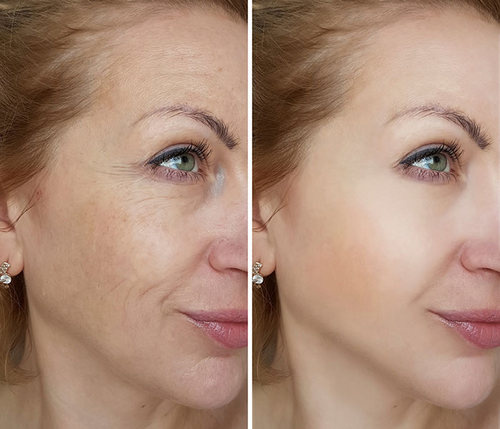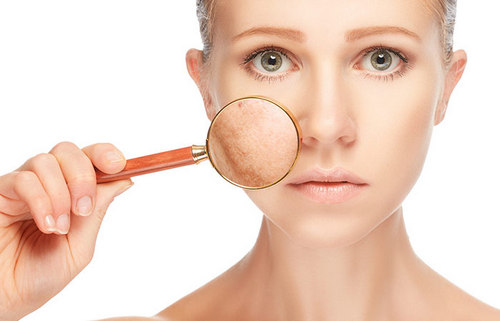From acne scars to enlarged pores, microneedling is currently the answer to all your skin-related woes. Here is everything you need to know about this skin care trend.
Imagine hundreds of tiny needles poking the skin all over your face. How does it sound? Painful, right?
But, here’s the thing – it is the hottest trend in the beauty industry right now.
Table Of Contents
What Is Microneedling?
A needle is probably the last thing that you would want to put on your face. However, this procedure has been around for a while. The practice of microneedling was introduced in the early 90s, though it has gained traction only in the past few years.

Microneedling is a procedure in which thousands of tiny needles are used to create puncture wounds on the topmost layer of your skin. Don’t worry, they feel like pinpricks and don’t damage your skin. All this tricks your skin into thinking that it is injured and accelerates collagen production and healing. Microneedling is performed by trained dermatologists, plastic surgeons, and aestheticians.
This is a minimally invasive procedure and is considered safe. It is used to improve skin texture and treat skin issues such as wrinkles, acne scarring, fine lines, brown spots, and pigmentation.
Its ability to give facial skin a youthful appearance has made microneedling extremely popular among skin care fanatics. However, you will need multiple sessions to see the full results of this treatment.
You must be wondering how this procedure is carried out. Here’s some insight into what goes on behind-the-scenes.
Microneedling: The Procedure
First off, your skin needs to be prepped before you undergo the procedure. Generally, your skin is prepared with a formulation containing vitamins A and C a month before microneedling. This pumps up the collagen production in your skin.

As for the actual procedure, microneedling is performed under topical anesthesia.
Here’s what you can expect on the day of the procedure:
- The dermatologist/plastic surgeon/aesthetician will start off by applying an antiseptic and cleaning your skin with a saline solution.
- Your skin is then stretched with hands, and a dermaroller (a pen-like device with needles) is rolled onto it 5 times in all directions (vertical, horizontal, and diagonal).
- There will be pinpoint bleeding from the punctures, which is controlled easily.
- Once the procedure is over, a saline formula or an ice pack is applied to the area.
- A collagen enhancing serum is also applied to the area.
The microneedling procedure is repeated on a regular basis over the next few months.
The post-care routine that you follow after microneedling makes all the difference. Here are some things you need to do after undergoing this procedure.
Aftercare Tips For Microneedling
- Avoid Sun Exposure: Stay out of the sun. Cover your face properly if you do step out in the sun. Do not apply just any sunscreen on your face. Your skin’s pores remain open after the procedure, and the harmful chemicals present in these sunscreens can get absorbed into your skin easily and damage it. Use only the products suggested by the microneedling professional.
- Keep It Clean: Use a very mild cleanser to clean your face during the 72 hours after the procedure. Do not use any harsh products on your face the following week.
- No Active Ingredients: Avoid using any skin care products that contain active ingredients like retinol, alpha hydroxy acids, and other such chemicals as your skin will be highly sensitive following the procedure.
- Avoid Using Makeup: Let your skin breathe and recover after microneedling. Avoid applying makeup on your face as the chemicals in the products can irritate your skin.
- Stimulate It With Collagen: You will be prescribed collagen stimulating peptides after microneedling. Use them religiously to assist your skin in producing more collagen and aid quick recovery.
- Drink Plenty Of Water: Staying hydrated helps your skin recover faster.
Microneedling is a fairly painless procedure that offers a ton of benefits. Here a few ways in which microneedling works wonders on your skin.
What Are The Benefits Of Microneedling?
1. Reduces Fine Lines And Wrinkles, And Tightens The Skin
Microneedling promotes collagen and elastin production in your skin, creating a youthful glow. A study observed that collagen production improved after multiple sessions of microneedling. When your collagen levels increase, your skin becomes supple and more elastic. It also reduces fine lines, wrinkles, and the size of pores. In other words, it can help you shed years off your face.

2. Heals Visible Scars On Your Face
Acne scars are notorious for not fading. However, a study conducted in 2009 found that microneedling helped in minimizing acne scars and improved the appearance of skin. It was found to be effective in healing boxcar and rolling scars.
3. Minimizes Pigmentation and Sun Damage
Microneedling refreshes the appearance of your skin by minimizing the appearance of pigmentation caused by excessive sun exposure. A study published in 2015 found that microneedling could reduce melasma effectively, a condition that causes dark patches on the skin.

4. Shrinks Skin Pores
If you think that microneedling enlarges skin pores, you are mistaken. It helps in shrinking pores by stimulating collagen development around them.
5. Improves The Effectiveness Of Topical Medicine
Most of the products that you apply on your face are not properly absorbed by your skin. This affects the efficacy of the product. A study has shown that microneedling can help topical medicine penetrate your skin more effectively, thus helping you get the full benefit of its ingredients. The micro-holes created by the microneedling process make your skin readily absorb whatever is applied to it.

You get the maximum benefits of microneedling when it is done by a professional. But, the device that they use also plays a crucial role. Following are the different types of devices used in microneedling.
Types Of Devices Used For Microneedling
Dermarollers are the devices used to perform microneedling. A variety of these rollers are available in the market. However, all these dermarollers are adopted from five basic types of rollers approved by the FDA.

These are:
- The C-8 or Cosmetic Type Dermaroller
The needle length of this dermaroller is 0.13 mm. These are commonly available in the market and can be used for at-home microneedling treatment. These needles are painless.
- The C-8HE or Cosmetic Type For Hair Bearing Surfaces
The length of the needles on this device is 0.2 mm, and it is mostly used on the scalp. These needles are also painless.
- CIT- 8 or Collagen Induction Therapy
This is a professional or medical-type dermaroller that has a needle length of 0.5mm. This device is used for collagen synthesis and skin remodeling.
The needle size of this device is 1.5 mm, and it is used for creating microchannels in the deeper layers of your skin. It is used for treating scars.
Compared to all the other dermarollers, this one has a small cylinder covered in 96 needles of 1.5 mm. This device is used for areas that demand precision and deeper penetration.
Apart from these basic types, the most common types of dermarollers available on the market include:
- Dermapen: This looks like a small pen and has a small circular head covered in needles.
- Dermastamp: This looks similar to a dermapen, but it has a large head holding more needles. It needs to be stamped on the face.
- LED Microneedling Device: This device has needles along with an LED light and is used for treating scarring and wrinkles.
Although microneedling is strictly a professional procedure, microneedling devices have become readily available in the past few years. A lot of women are trying out microneedling at home. Professionals and dermatologists usually do not approve of such DIY measures because you can end up injuring your skin. There are many risks associated with it that you need to be aware of. Just keep reading to find out more.
Microneedling At Home: What Are The Risks?
DIY microneedling at home is undoubtedly less expensive, but it comes with its set of risks.
- At-home microneedling devices do not offer uniform application. Therefore, they can cause deeper wounds and flare up your acne breakouts. Usually, at-home microneedling devices have needles that are 0.2 mm to 1 mm in length. These can give you open wounds and can be quite painful.
- At-home devices are not as sterile as professional devices. Thus, they can increase your chances of contracting herpes infection. If you already suffer from skin conditions such as rosacea and psoriasis, self-microneedling can worsen them.
- Holding that device and rolling it on your skin requires a unique technique that professionals are trained to perform. Even if you think that you are doing it right, chances are that you are actually damaging your skin. The needles need to be pushed in at the correct angle and at a specific depth to prevent irritation and damage to your skin.
- People who do DIY-microneedling are more at risk of developing skin issues because they may not be following the correct aftercare steps. Not taking care of your skin after microneedling may cause major skin issues in the long run.

Yes, there will be a teeny-weeny bit of pain and blood. And yes, it takes a lot of courage to let those needles prick your skin. But, as Renoir said, “The pain passes, but the beauty remains.” The smooth and healthy skin that you get after microneedling treatment is worth it. However, don’t forget to consult an expert or a dermatologist before getting it done. Good luck!
Have any doubts or questions about this interesting skin care procedure? Let us know in the comments section below!
Expert’s Answers for Readers Questions
Are microneedling results permanent?
Yes, the results of microneedling are permanent. However, if the underlying cause of your skin condition is not treated, it may resurface.
What’s the cost of microneedling?
The cost of microneedling can be anywhere between $100 and $700 per session.
What’s the downtime for microneedling?
It depends on the depth of the treatment. Usually, the swelling and redness go away in 2-3 days.
References
- “Microneedling: Advances and widening horizons.” Indian Dermatology Online Journal, NCBI
- “Multiple microneedling sessions.” International Journal of Dermatology, NCBI
- “Microneedling Therapy in Atrophic Facial Scars..” Journal of Cutaneous and Aesthetic Surgery, NCBI
- “Microneedling in facial recalcitrant melasma..” AnaisBrasileiros deDermatologia, NCBI
- “Skin penetration enhancement..” European Journal of Pharmaceutical Sciences, Science Direct
- “Automated Microneedling Device..” Journal of Pakistan Association of Dermatologists, ResearchGate



Howdy this is kind of of off topic but I was wanting to know if blogs use WYSIWYG editors or if you have to manually code with HTML. I’m starting a blog soon but have no coding knowledge so I wanted to get advice from someone with experience. Any help would be greatly appreciated!